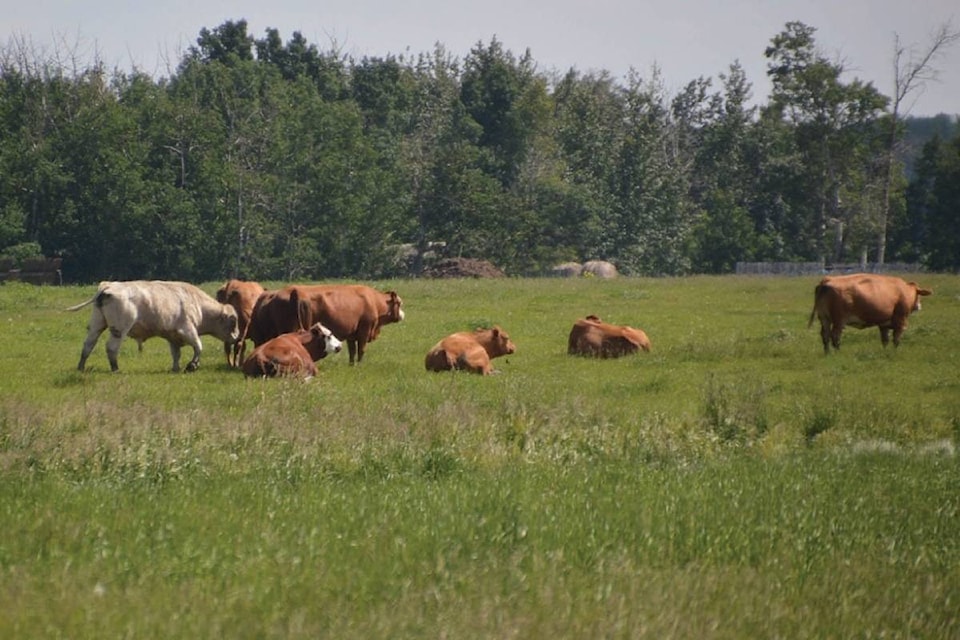In a year where feed supplies are tight, knowing which cows are pregnant and which ones are open provides options that may not otherwise be available.
“Feed can amount to two-thirds of a beef operation’s total costs,” says Ted Nibourg, farm business management specialist at the Alberta Ag-Info Centre. “Carefully considering the feeding program could mean the difference between profitability and red on the bottom line of the balance sheet. With feed costs on the rise, keeping the open animals could cut into profitability.”
Strong selection practices can also help reduce the feed requirements of the herd.
“Feed costs can vary from around $1.88 per cow on a straw/grain/canola meal diet, with straw valued at 3 cents a pound and $180 per tonne for barley. That feed cost can be around $2.50 per cow if she is fed a straight hay diet, and the hay is valued at 7 cents per lb,” explains Barry Yaremcio, beef and forage specialist at the Ag-Info Centre. “In a herd of 100 cows, the cheaper ration would save $62 per day.”
Knowing the status of each cow provides the chance to wean her calf early if she is open and to take advantage of the market.
“If an open cow is thin, weaning early allows easier fattening for market,” says Andrea Hanson, livestock extension specialist with Alberta Agriculture and Forestry. “Preg checking yearling heifers early allows the open ones to be sold at an age that would still bring top dollar.”
New ultrasound technology means that a pregnancy can be detected as early as 40 days.
“Speak with your veterinarian to determine what they require and their schedule,” says Hanson. “Then, develop a game plan for preg testing this fall.”
Hanson adds that some producers have tightened up their breeding season as a way to identify the most fertile females in the herd.
“They are exposing replacement heifers to a bull for 30 days, with a 45 day exposure for the rest of the cow herd. Adequate bull power is very important in this scenario to ensure the fertile females are bred during a small window of time,” she says. “While this system for breeding may seem extreme, in a year when feed supplies are tight and costs high, looking for excuses to strategically select are not a bad idea and will create a very productive herd for the future.”
For a commercial cattle producer, profitability of the operation depends on the GOLD management indicators:
G – growth of the calves
O – open rate
L – length of calving
D – death loss
“Bottom line is pounds of calf weaned to cows exposed to the bull,” notes Hanson. “Any cow not pulling her weight by raising a calf needs to be removed from the herd so she isn’t eating up the profits of the operation.”
As for the economic value of preg checking, Nibourg says that it depends on market prices, the producer’s management system, feed and overhead costs as well as veterinary costs.
“Higher values in the spring and additional weight put on in the winter may offset higher feeding costs,” Nibourg says. “The Canfax fact sheet The Economics of Preg-Checking (PDF, 560 KB) provides some useful context. Higher feed and overwintering costs favour pregnancy checking and selling the cows in the fall. With more residue in the cropping fields, extending the grazing into the fall show more potential than the past few years.”
Cow value is often a more important factor in the economics of pregnancy checking than either overwintering or veterinary costs.
“During November, cull cow prices were tracking between 72 and 88 cents per lb,” adds Nibourg. “Knowing the body condition score of the cows is also critical. It is often helpful to get a second opinion on the cows’ conditions. For a 1400 lb cow valued at $80 per cwt now and feeding for maintenance for 90 days at $2.10 per day feed cost – 35 lbs of hay at 6 cents per lb – keeping her pencils out to just above break-even, yet you still have to deal with her. Take that same cow in fair body condition who could gain 200 lbs before selling her, even with the same fall selling price. Add that weight and use the same feeding cost means a net gain of about $150. The key is that the cow is gaining valuable weight and not just maintaining it.”
“Watch for declining prices from fall to spring, as this will encourage pregnancy checking. The Beef Cattle Research Council has developed the Economics of Pregnancy Testing Beef Cattle Model which is simple to use and effective in showing the economics of preg checking”.
-Alberta Agri-news
